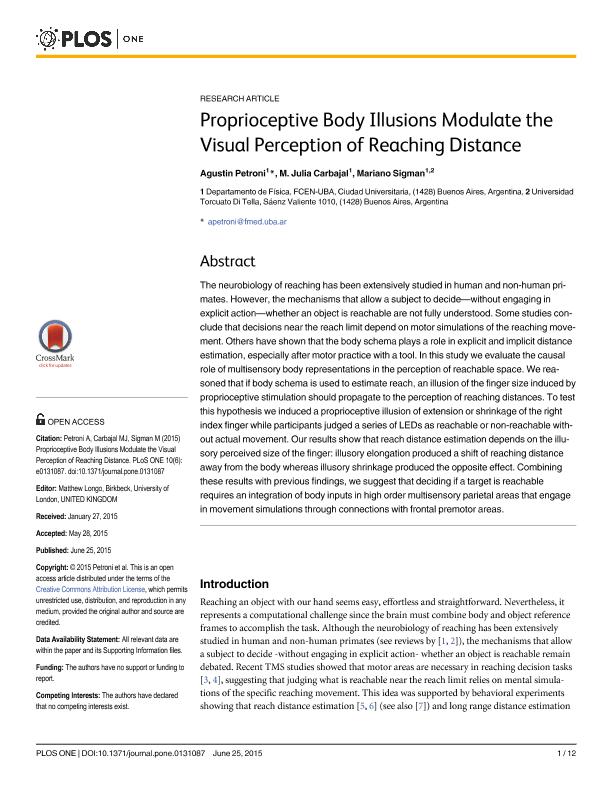Mostrar el registro sencillo del ítem
dc.contributor.author
Petroni, Agutin
dc.contributor.author
Carbajal, María Julia

dc.contributor.author
Sigman, Mariano

dc.date.available
2018-05-30T14:24:19Z
dc.date.issued
2015-06-25
dc.identifier.citation
Petroni, Agutin; Carbajal, María Julia; Sigman, Mariano; Proprioceptive Body Illusions Modulate the Visual Perception of Reaching Distance; Public Library of Science; Plos One; 10; 6; 25-6-2015; 1-12; e0131087
dc.identifier.issn
1932-6203
dc.identifier.uri
http://hdl.handle.net/11336/46595
dc.description.abstract
The neurobiology of reaching has been extensively studied in human and non-human primates. However, the mechanisms that allow a subject to decide?without engaging in explicit action?whether an object is reachable are not fully understood. Some studies conclude that decisions near the reach limit depend on motor simulations of the reaching movement. Others have shown that the body schema plays a role in explicit and implicit distance estimation, especially after motor practice with a tool. In this study we evaluate the causal role of multisensory body representations in the perception of reachable space. We reasoned that if body schema is used to estimate reach, an illusion of the finger size induced by proprioceptive stimulation should propagate to the perception of reaching distances. To test this hypothesis we induced a proprioceptive illusion of extension or shrinkage of the right index finger while participants judged a series of LEDs as reachable or non-reachable without actual movement. Our results show that reach distance estimation depends on the illusory perceived size of the finger: illusory elongation produced a shift of reaching distance away from the body whereas illusory shrinkage produced the opposite effect. Combining these results with previous findings, we suggest that deciding if a target is reachable requires an integration of body inputs in high order multisensory parietal areas that engage in movement simulations through connections with frontal premotor areas.
dc.format
application/pdf
dc.language.iso
eng
dc.publisher
Public Library of Science

dc.rights
info:eu-repo/semantics/openAccess
dc.rights.uri
https://creativecommons.org/licenses/by-nc-sa/2.5/ar/
dc.subject
Vision
dc.subject
Triceps
dc.subject
Reaction Time
dc.subject
Psycological Parameters
dc.subject.classification
Física Atómica, Molecular y Química

dc.subject.classification
Ciencias Físicas

dc.subject.classification
CIENCIAS NATURALES Y EXACTAS

dc.title
Proprioceptive Body Illusions Modulate the Visual Perception of Reaching Distance
dc.type
info:eu-repo/semantics/article
dc.type
info:ar-repo/semantics/artículo
dc.type
info:eu-repo/semantics/publishedVersion
dc.date.updated
2018-05-04T21:30:21Z
dc.journal.volume
10
dc.journal.number
6
dc.journal.pagination
1-12; e0131087
dc.journal.pais
Estados Unidos

dc.journal.ciudad
San Francisco
dc.description.fil
Fil: Petroni, Agutin. Universidad de Buenos Aires. Facultad de Ciencias Exactas y Naturales. Departamento de Física; Argentina
dc.description.fil
Fil: Carbajal, María Julia. Universidad de Buenos Aires. Facultad de Ciencias Exactas y Naturales. Departamento de Física; Argentina
dc.description.fil
Fil: Sigman, Mariano. Universidad de Buenos Aires. Facultad de Ciencias Exactas y Naturales. Departamento de Física; Argentina. Universidad Torcuato di Tella; Argentina
dc.journal.title
Plos One

dc.relation.alternativeid
info:eu-repo/semantics/altIdentifier/url/http://www.plosone.org/article/metrics/info%3Adoi%2F10.1371%2Fjournal.pone.0131087
dc.relation.alternativeid
info:eu-repo/semantics/altIdentifier/doi/http://dx.doi.org/10.1371/journal.pone.0131087
Archivos asociados
